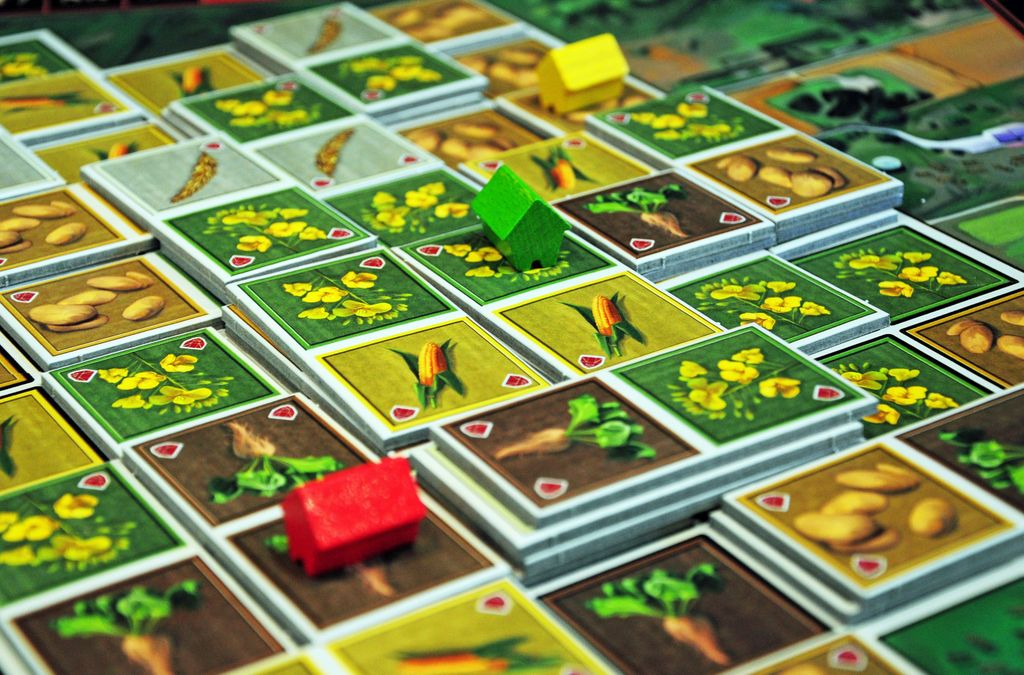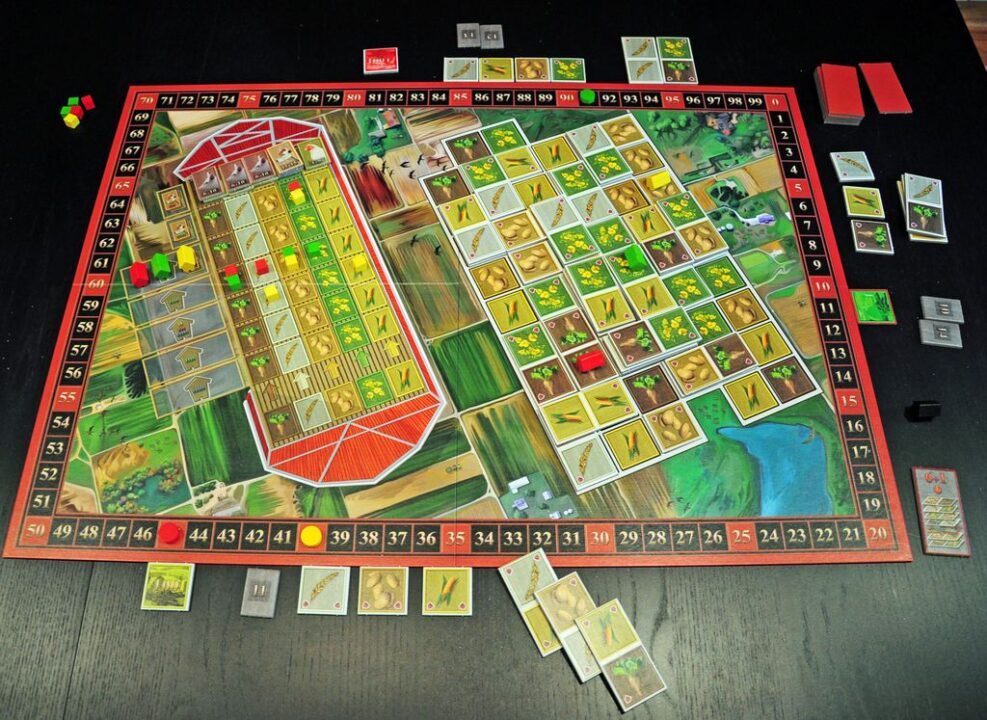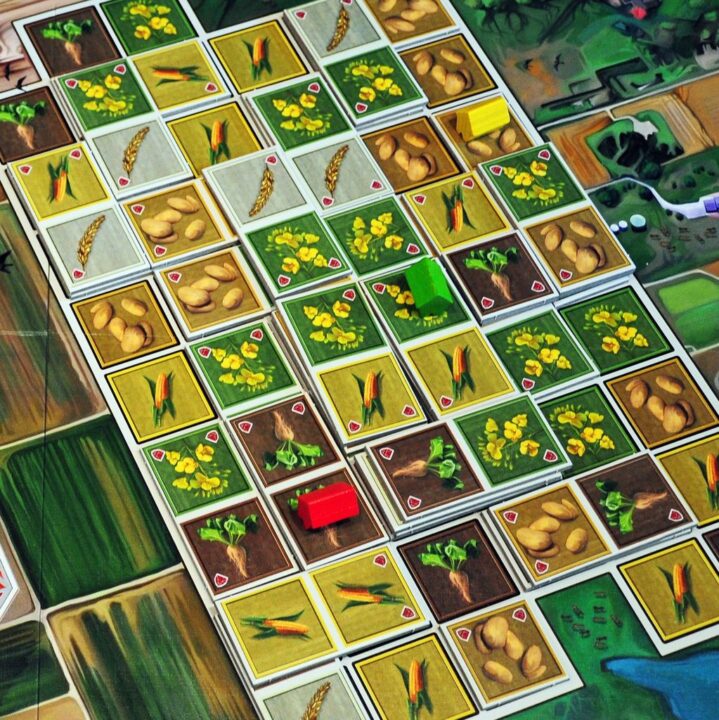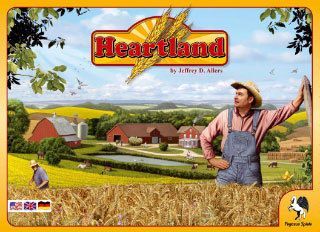Welcome folks! Today, I’m thrilled to share my review of the board game ‘Heartland‘. If you love vibrant design, engaging mechanics, and don’t mind a bit of luck, this might be your next favorite. Of course, I’ll also highlight any hiccups I found along the way. So, grab a snack, settle in, and let’s see if Heartland deserves a prime spot in your board game collection!
How It Plays
Setting Up
First, lay out the board and shuffle the tiles. Each player picks a character and gets their own farm board. Place the resources nearby. Don’t forget to give each player their starting hand of tiles and resources. You’re ready to farm!
Gameplay
On your turn, draw a tile and place it on your farm board. You can trade resources, plant crops, or harvest them. Keep an eye on what your neighbors are doing; sometimes blocking them can be as strategic as growing your own farm. Balancing your resources and using them wisely is key.
Winning the Game
The game ends when someone draws the last tile. Everyone tallies their points based on their crops, resources, and completed objectives. The player with the most points wins and becomes the ultimate Heartland farmer. So, get farming and may the best strategist win!
Want to know more? Read our extensive strategy guide for Heartland.
Game Mechanics and Balance in Heartland
I’ve got a bone to pick with game mechanics and balance, especially when it comes to board games. Heartland is on my radar today, and I’ve mixed feelings. Now, don’t get me wrong, it’s a fun game with several strengths, but it’s important to dive into the mechanics and balance to give a fair review.
Heartland takes you on a farming adventure, where players compete to grow the best crops and raise the happiest animals. The game mechanics are straightforward, which is great for new gamers. You move your pieces, plant crops, and expand your farm with tiles. The tile placement is crucial, and if you mess it up, you can find yourself in a pickle.
But here’s the kicker: balance. Heartland tries to level the playing field by giving all players the same resources at the start. But, as the game progresses, the luck factor sneaks in. Drawing tiles can feel like rolling dice. If you’re lucky, you get the tiles you need to boost your farm. If not, well, tough luck. This can make the game feel a bit unfair and can frustrate those who prefer strategy over chance.
I’ve had games where I dominated, and others where I couldn’t catch a break. My friend Greg was on fire once, and I swear he could’ve built the whole farm in one turn! Meanwhile, I was left with a handful of useless tiles, feeling like a farmer without a plow. It detracts from the overall experience when luck plays too big a role.
Next up, let’s dig into the replayability and engagement factors that keep players coming back to Heartland.

Replayability and Engagement in Heartland
Alright folks, let’s talk replayability and engagement in Heartland. You know, the kind of game that keeps you coming back for more, like that endless bag of chips you can’t put down. Heartland, at first glance, gets you hooked with its down-to-earth farming theme. It’s like Stardew Valley decided to throw itself a cardboard party.
Now, I’ve played Heartland a bunch of times with my crew. We’ve had our share of laughs, strategy talks, and eye rolls. The game has a solid mix of planning and competition. The crop rotation and livestock management give you a lot to think about. But, on the seventh or eighth playthrough, it starts to get a bit… predictable. The tiles and resources don’t change much from game to game, which can make things feel repetitive.
Don’t get me wrong. There’s a lot to love here. Heartland’s charm lies in its simple yet engaging gameplay. You can teach it to someone new in under 10 minutes, and that’s a win in my book. Plus, the satisfaction of seeing your farm grow is always a nice touch. But, if you’re the type who craves variety and twists, you might find yourself yearning for more after a few sessions.
The game does try to keep things fresh with different strategies you can adopt. The challenge of out-farming your pals can be addictive. Still, after a few rounds, you may start seeing the same patterns and strategies over and over. It’s like that joke you heard last week – funny the first time, not so much the tenth.
In the next section, we’ll dive into the nitty-gritty of Heartland’s design and component quality. Grab your pitchforks!

Design and Component Quality in Heartland: A Feast for the Eyes?
Alright folks, let’s chat about Heartland’s design and component quality. First off, the box art looks like something you’d find on a vintage postcard. It’s vibrant and invites you to explore the game world. Inside, you’ll find a game board that’s sturdy enough to double as a makeshift coffee table if needed.
The tiles are thick, colorful, and textured in a way that makes shuffling them oddly satisfying. You can’t help but feel a little bit like a farmer arranging your fields and barns. The cards are standard size and made from durable material, but they could benefit from a linen finish. Sleeving them might be a good idea if you’re as clumsy with game pieces as I am.
The meeples! Oh, the meeples! Heartland brings a little zest with meeples shaped like various farm animals. These delightful little critters add a cute charm to the game, and they’re fun to move around. However, be warned: you’ll need a decent-sized table because once you get all the tiles, cards, and meeples out, it’s like a small farm exploded in your living room.
One small gripe? The storage solution, or rather, the lack of it. Heartland comes with a standard cardboard insert that doesn’t do much in terms of organizing your pieces. After a few plays, it starts feeling like you’re packing away a jigsaw puzzle with missing pieces. A custom insert or some ziplock bags could solve this minor headache.
Now that we’ve covered the design and component quality, let’s move on to the next section: Fun factor and player interaction, where things get really interesting!

Heartland: Fun Factor and Player Interaction
The fun factor in Heartland is as rich as the farmlands you’re cultivating! The game makes you feel like a true farmer boss, managing crops and livestock with pride. I remember a session where my friend Dave ended up with a farm composed entirely of chickens. While he didn’t win, the clucking sounds he made for each chicken move definitely added to our amusement. Each turn is packed with decisions that make you feel like you’re in control, even if you end up overrun by cows instead of corn.
Player interaction in Heartland isn’t just a side dish; it’s the main course. The game benefits from strategic plays and sneaky moves. In one game, my buddy Lisa decided to sabotage my perfect cornfield by placing her barn right smack in the middle of my land! The laughter—and mock rage—that followed added a lot of spice to our game night. It’s these moments that make Heartland worth playing with a group.
The game encourages a healthy dose of rivalry without turning into a grudge match. You can compete for the best plots of land and resources, but it never feels cutthroat. One minute, you’re plotting your next big move, the next, you’re laughing over someone’s failed attempt at livestock management. These elements make Heartland a blast, especially for groups who enjoy a bit of friendly competition.
Do I recommend Heartland? Absolutely! If you’re looking for a game that delivers hearty laughs and engaging player interaction, this game should be on your shelf.
Conclusion
Heartland is a charming game with vibrant design and durable components. It has straightforward mechanics, making it accessible for both new and experienced players. The game shines in its strategic player interactions and fun factor. However, the reliance on luck and limited variety may hinder replayability and balance. If you enjoy light-hearted games and don’t mind a bit of unpredictability, Heartland is well worth a try. Thanks for reading this review!


